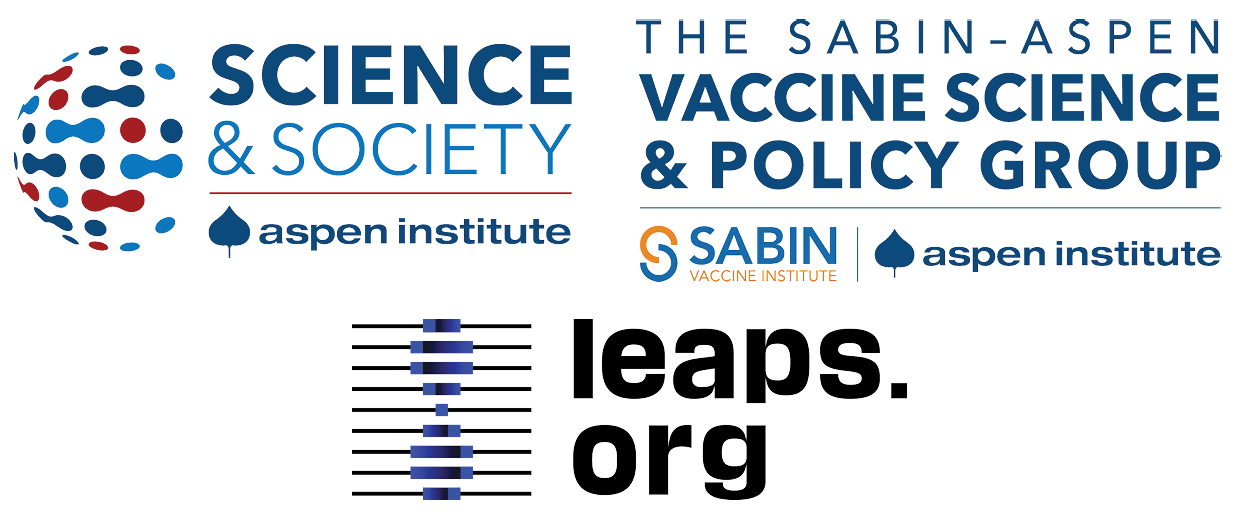Dec. 17th Event: The Latest on Omicron, Boosters, and Immunity
Kira Peikoff was the editor-in-chief of Leaps.org from 2017 to 2021. As a journalist, her work has appeared in The New York Times, Newsweek, Nautilus, Popular Mechanics, The New York Academy of Sciences, and other outlets. She is also the author of four suspense novels that explore controversial issues arising from scientific innovation: Living Proof, No Time to Die, Die Again Tomorrow, and Mother Knows Best. Peikoff holds a B.A. in Journalism from New York University and an M.S. in Bioethics from Columbia University. She lives in New Jersey with her husband and two young sons. Follow her on Twitter @KiraPeikoff.

The Omicron variant poses new uncertainty for the vaccines, which four leading experts will address during our virtual event on December 17th, 2021.
This virtual event will convene leading scientific and medical experts to discuss the most pressing questions around the new Omicron variant, including what we know so far about its ability to evade COVID-19 vaccines, the role of boosters in eliciting heightened immunity, and the science behind variants and vaccines. A public Q&A will follow the expert discussion.
EVENT INFORMATION:
Date: Friday Dec 17, 2021
2:00pm - 3:30pm EST

Dr. Céline Gounder, MD, ScM, is the CEO/President/Founder of Just Human Productions, a non-profit multimedia organization. She is also the host and producer of American Diagnosis, a podcast on health and social justice, and Epidemic, a podcast about infectious disease epidemics and pandemics. She served on the Biden-Harris Transition COVID-19 Advisory Board.
 Dr. Theodora Hatziioannou, Ph.D., is a Research Associate Professor in the Laboratory of Retrovirology at The Rockefeller University. Her research includes identifying plasma samples from recovered COVID-19 patients that contain antibodies capable of neutralizing the SARS-CoV-2 coronavirus.
Dr. Theodora Hatziioannou, Ph.D., is a Research Associate Professor in the Laboratory of Retrovirology at The Rockefeller University. Her research includes identifying plasma samples from recovered COVID-19 patients that contain antibodies capable of neutralizing the SARS-CoV-2 coronavirus.

Dr. Onyema Ogbuagu, MBBCh, is an Associate Professor at Yale School of Medicine and an infectious disease specialist who treats COVID-19 patients and leads Yale’s clinical studies around COVID-19. He ran Yale’s trial of the Pfizer/BioNTech vaccine.

Dr. Eric Topol, M.D., is a cardiologist, scientist, professor of molecular medicine, and the director and founder of Scripps Research Translational Institute. He has led clinical trials in over 40 countries with over 200,000 patients and pioneered the development of many routinely used medications.
This event is the fourth of a four-part series co-hosted by Leaps.org, the Aspen Institute Science & Society Program, and the Sabin–Aspen Vaccine Science & Policy Group, with generous support from the Gordon and Betty Moore Foundation and the Howard Hughes Medical Institute.

Kira Peikoff was the editor-in-chief of Leaps.org from 2017 to 2021. As a journalist, her work has appeared in The New York Times, Newsweek, Nautilus, Popular Mechanics, The New York Academy of Sciences, and other outlets. She is also the author of four suspense novels that explore controversial issues arising from scientific innovation: Living Proof, No Time to Die, Die Again Tomorrow, and Mother Knows Best. Peikoff holds a B.A. in Journalism from New York University and an M.S. in Bioethics from Columbia University. She lives in New Jersey with her husband and two young sons. Follow her on Twitter @KiraPeikoff.
Epigenetic therapeutics could revolutionize medicine in the coming decades. (© kentoh/Adobe)
How exactly does your DNA make you who you are?
It's because of epigenetics that identical twins can actually look different and develop different diseases.
Just as software developers don't write apps out of ones and zeros, the interesting parts of the human genome aren't written merely in As, Ts, Cs and Gs. Yes, these are the fundamental letters that make up our DNA and encode the proteins that make our cells function, but the story doesn't end there.
Our cells possess amazing abilities, like eating invading bacteria or patching over a wound, and these abilities require the coordinated action of hundreds, if not thousands, of proteins. Epigenetics, the study of gene expression, examines how multiple genes work at once to make these biological processes happen.
It's because of epigenetics that identical twins – who possess identical DNA -- can actually look different and develop different diseases. Their environments may influence the expression of their genes in unique ways. For example, a research study in mice found that maternal exposure to a chemical called bisphenol A (BPA) resulted in drastic differences between genetically identical offspring. BPA exposure increased the likelihood that a certain gene was turned on, which led to the birth of yellow mice who were prone to obesity. Their genetically identical siblings who were not exposed to BPA were thinner and born with brown fur.

These three mice are genetically identical. Epigenetic differences, however, result in vastly different phenotypes.
(© 1994 Nature Publishing Group, Duhl, D.)
This famous mouse experiment is just one example of how epigenetics may transform medicine in the coming years. By studying the way genes are turned on and off, and maybe even making those changes ourselves, scientists are beginning to approach diseases like cancer in a completely new way.
With few exceptions, most of the 1 trillion cells that make up your body contain the same DNA instructions as all the others. How does each cell in your body know what it is and what it has to do? One of the answers appears to lie in epigenetic regulation. Just as everyone at a company may have access to all the same files on the office Dropbox, the accountants will put different files on their desktop than the lawyers do.
Our cells prioritize DNA sequences in the same way, even storing entire chromosomes that aren't needed along the wall of the nucleus, while keeping important pieces of DNA in the center, where it is most accessible to be read and used. One of the ways our cells prioritize certain DNA sequences is through methylation, a process that inactivates large regions of genes without editing the underlying "file" itself.
As we learn more about epigenetics, we gain more opportunities to develop therapeutics for a broad range of human conditions, from cancer to metabolic disorders. Though there have not been any clinical applications of epigenetics to immune or metabolic diseases yet, cancer is one of the leading areas, with promising initial successes.
One of the challenges of cancer treatments is that different patients may respond positively or negatively to the same treatment. With knowledge of epigenetics, however, doctors could conduct diagnostic tests to identify a patient's specific epigenetic profile and determine the best treatment for him or her. Already, commercial kits are available that help doctors screen glioma patients for an epigenetic biomarker called MGMT, because patients with this biomarker have shown high rates of success with certain kinds of treatments.
Other epigenetic advances go beyond personalized screening to treatments targeting the mechanism of disease. Some epigenetic drugs turn on genes that help suppress tumors, while others turn on genes that reveal the identity of tumor cells to the immune system, allowing it to attack cancerous cells.
Direct, targeted control of your epigenome could allow doctors to reprogram cancerous or aging cells.
The study of epigenetics has also been fundamental to the field of aging research. The older you get, the more methylation marks your DNA carries, and this has led to the distinction between biological aging, or the state of your cells, and chronological aging, or how old you actually are.
Just as our DNA can get miscopied and accumulate mutations, errors in DNA methylation can lead to so-called "epimutations". One of the big hypotheses in aging research today is that the accumulation of these random epimutations over time is responsible for what we perceive as aging.
Studies thus far have been correlative - looking at several hundred sites of epigenetic modifications in a person's cell, scientists can now roughly discern the age of that person. The next set of advances in the field will come from learning what these epigenetic changes individually do by themselves, and if certain methylations are correlated with cellular aging. General diagnostic terms like "aging" could be replaced with "abnormal methylation at these specific locations," which would also open the door to new therapeutic targets.
Direct, targeted control of your epigenome could allow doctors to reprogram cancerous or aging cells. While this type of genetic surgery is not feasible just yet, current research is bringing that possibility closer. The Cas9 protein of genome-editing CRISPR/Cas9 fame has been fused with epigenome modifying enzymes to target epigenetic modifications to specific DNA sequences.
A therapeutic of this type could theoretically undo a harmful DNA methylation, but would also be competing with the cell's native machinery responsible for controlling this process. One potential approach around this problem involves making beneficial synthetic changes to the epigenome that our cells do not have the capacity to undo.
Also fueling this frontier is a new approach to understanding disease itself. Scientists and doctors are now moving beyond the "one defective gene = one disease" paradigm. Because lots of diseases are caused by multiple genes going haywire, epigenetic therapies could hold the key to new types of treatments by targeting multiple defective genes at once.
Scientists are still discovering which epigenetic modifications are responsible for particular diseases, and engineers are building new tools for epigenome editing. Given the proliferation of work in these fields within the last 10 years, we may see epigenetic therapeutics emerging within the next couple of decades.
Goodnight, Moon. Goodnight, Sky Advertisement.
A rendering of what a sky advertisement would look like.
Imagine enjoying a romantic night stargazing, cozying up for the evening – and you catch a perfectly timed ad for Outback Steakhouse.
Countries have sovereignty over their airspace, but the night sky itself is pretty much an open field.
That's the vision of StartRocket, a Russian startup planning to put well-lit advertisements into outer space. According to a recent interview, StartRocket says its first client is PepsiCo.
The Lowdown
Launching at twilight during the early morning or early evening, the ads will be on cubesats – 10 cm square metallic boxes traditionally used in space. The attached Mylar sails will reflect light from the rising or setting sun, making the ad appear like an "orbital billboard."
The advertisements will need all the solar power they can get: According to a 2016 report, 80 percent of the world and 99 percent of America and Europe experience light pollution at night. Showing advertisements in, say, Wyoming will be much easier than attracting attention in Midtown Manhattan – and risks adding a considerable amount of light pollution to an already overburdened night sky.
Next Up
The StartRocket advertising program is set to begin in 2021. The most recent rate is $20,000 for eight hours of advertising space.
But first, StartRocket has to win over consumers, regulators and space activists.
"I don't see it taking off now," says TED Fellow and University of Texas, Austin Associate Professor Dr. Moriba Jah. Jah is the creator of Astriagraph, an interactive tool to help monitor space junk orbiting Earth. "In general, the space community is anathema to advertisements from orbit to people on the ground… The global astronomy community will be fighting it tooth and nail."
Jah notes SpaceX's launch of 60 satellites last month. "Astronomers were up in arms since they are so bright, you can see them with the naked eye." It got to the point where Elon Musk had to defend himself to the astronomy community on Twitter.
Open Questions
Startups come and go, especially those that are looking for funding. StartRocket is in both categories. Frankly, it's unclear if the ads will actually launch two years from now.
Space advertisements are more likely to be the future for less regulated and financially strapped areas.
The regulatory hurdles are just as unknown. According to Jah, countries have sovereignty over their airspace (think planes, balloons and drones), but the night sky itself is pretty much an open field. This doesn't remove the political ramifications, though, and any American-based launches would have to contend with the FCC, since it regulates advertisements, and the FAA, since it regulates flight.
Carbon credits-style redemptions may help balance out the potential environmental and political damage done by sky ads. It isn't a coincidence that space pioneers Musk, Jeff Bezos, and Richard Branson succeeded at other ventures first, giving them considerably deep pockets to survive red tape – something StartRocket's team doesn't have at the moment.
Space advertisements are more likely to be the future for less regulated, financially strapped areas. Depending on how ad companies negotiate with the local governments, it's easy to picture Kolkata with an "Enjoy Coke" advertisement blaring during a Ganges sunset.
"In rural places, it would be like having another moon," Jah says. "People would say the rich are now taking the sky away from us."

